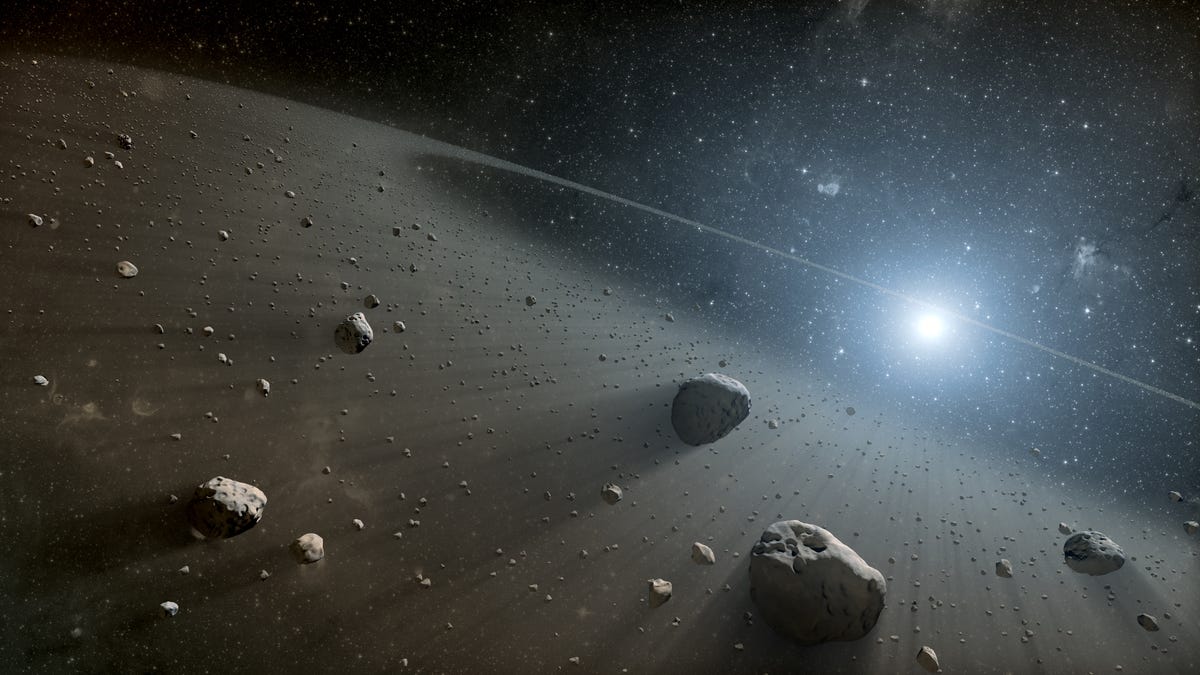Astronomers Spot Two Unusually Red Objects in the Asteroid Belt - 4 minutes read

They’re red, they’re reasonably big, and they have no business being in the main asteroid belt, but their discovery confirms the complex conditions in place when the solar system was still forming.
New research published in the The Astrophysical Journal Letters details the discovery of two extremely red main-belt asteroids. Named 203 Pompeja and 269 Justitia, the asteroids have a redder spectral signature than any other asteroid in the main belt, that highly populated band of asteroids situated between the orbits of Mars and Jupiter. The new paper was led by Japan Aerospace Exploration Agency (JAXA) astronomer Sunao Hasegawa.
Importantly, these red asteroids resemble trans-Neptunian objects, that is, objects located farther away than Neptune, the most distant planet from the Sun (with no disrespect to dwarf planet Pluto). This could mean that 203 Pompeja and 269 Justitia formed way out there in the Kuiper Belt and then drifted inward when the solar system was still young. If confirmed, the new finding shows how chaotic the conditions were back then and that materials from different parts of the solar system would sometimes mix together.
The purpose of the study was to document the distribution and composition of large asteroids in the main belt. Large asteroids, especially those larger than 60 miles (100 km) in width, are likely survivors of the solar system’s early days. By studying these objects, the scientists were hoping to catch a glimpse of what the conditions were like some 4 billion years ago.
To do so, the astronomers made visible and near-infrared spectroscopic observations of the main belt using the Telescope Facility (IRTF) and Seoul National University Astronomical Observatory (SAO). This international collaboration involved scientists from MIT, the University of Hawai‘i, Seoul National University, Kyoto University, and several other institutions.
Asteroid 203 Pompeja measures 68 miles (110 km) in diameter, while 269 Justitia is just half as big. Both feature an unusually red spectrum, meaning they reflect a lot of red light. They’re even redder than D-type asteroids, which were previously believed to be the reddest objects in the asteroid belt.
The outer solar system is packed with materials left over from the formation of the solar system, including planetesimals (asteroids) and centaurs (icy planetesimals located between Jupiter and Neptune). These distant objects are very red, containing complex organic compounds like methane and methanol ice. These compounds, when viewed through a spectrograph, give an asteroid its reddish appearance. By contrast, objects in the inner solar system have scant traces of organic material, so they tend to reflect blue light.
Asteroids 203 Pompeja and 269 Justitia “are thought to have been formed near the outer edge of the Solar System beyond the distant organic snow line and then moved to the asteroid belt during the early epoch of the Solar System’s formation,” notes a JAXA press release. By “organic snow line,” the scientists are referring to the location in the solar system where methanol and methane turn into ice.
This finding suggests some asteroids in the main belt formed in the outer solar system, and that a population of these objects is likely to exist within the main belt. A good next step would be to determine the exact proportion of this red asteroid population. What’s more, the new study showcases the main belt as a good destination for a future mission. Instead of traveling to the outer edge of the solar system for samples of Kuiper Belt objects, all we’d have to do is send a probe to the asteroid belt, where it could study both inner object asteroids and those that formed far, far away.
More: Comet 67P repeatedly changed color during the historic Rosetta mission.
Source: Gizmodo.com
Powered by NewsAPI.org